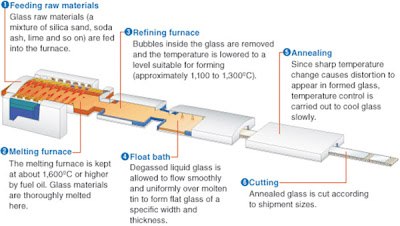Annealed float glass when breaks is a safety hazard, just because it breaks into sharp pieces and can injure. Imagine, if an annealed glass applied to a window in the 6th floor of a building, and if it breaks by accident, the sharp pieces of glass falls down, the magnitude of the danger increases when there are many people present in the ground floor.
 |
| Toughened glass when it breaks |
Glass is toughened so as to make it more stronger and less prone to breakage. Moreover, toughened or tempered glass, unlike annealed glass, breaks into small circular fragments, thereby decreasing the possibility of injuring anyone. Glass is toughened by heating it over 600°C in a furnace and then rapidly cooling by blowing air over a period of 3 to 10 seconds. Initially I was also not sure how glass could become more stronger just by heating and sudden cooling, but I gradually learned that this does work, mainly has to do with the physical properties of glass.
Toughened glass becomes stronger and gains its safety characteristics mainly because of the compressive and tensile stress built up caused by snap cooling. The sudden cooling of hot glass results in the cooling of the surface of the glass much faster than the center of the glass, this results in the contracting of the surface and building up of compressive stresses in this area. At this point, the center part of the glass expands and develops tensile stresses. During an impact, the force has to first penetrate the compressive stress region, when this layer is penetrated, the built up energy is released suddenly, as a result, glass breaks into small circular fragments instead of large sharp pieces. Toughening of glass increases the compressive stress region of the glass there by making it less penetrable to impact forces, and making it 4 to 5 times stronger than annealed glass.
 |
| A Glass Toughening Plant |
Quality of toughened glass can be mainly assessed by comparing the size of broken pieces. In a good quality toughening process, the broken pieces are small and consistent in size, whereas, in poor quality toughening the broken pieces are of comparatively larger in size and there will be variation in their sizes.
(Image courtesy:
http://www.breakglass.org/How-is-glass-made.html , http://bhatiaglass.com/images/inner/broken_glass.jpg&imgrefurl=http://bhatiaglass.com/about_toughened_glass/about_toughened_glass.htm&h=160&w=200&sz=19&tbnid=mJdvM6Od066GlM:&tbnh=83&tbnw=104&prev=/images% )

